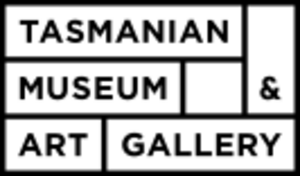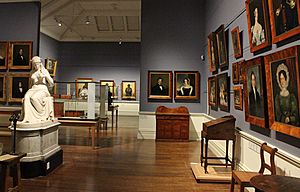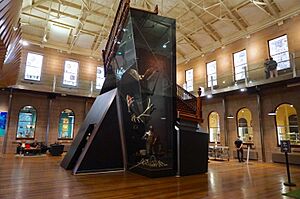Tasmanian Museum and Art Gallery facts for kids
 |
|
 |
|
| Established | 1843 |
|---|---|
| Location | Hobart, Tasmania, Australia |
| Visitors | 400,000 |
| Place ID: | 6,648 |
| Status: | Permanently Registered |
The Tasmanian Museum and Art Gallery (TMAG) is a cool place in Hobart, Tasmania, where you can explore history, art, and science. It's often called TMAG for short.
This museum was started way back in 1846 by the Royal Society of Tasmania. This society is actually the oldest "Royal Society" outside of England! Every year, about 400,000 people visit TMAG to see its amazing collections.
Contents
The Story of TMAG
How the Museum Began
The Tasmanian Museum and Art Gallery officially opened in 1848. However, the collections it holds are much older! Before TMAG, several groups tried to start museums. The most successful was the Mechanics' Institution of Hobart.
A lot of the work to create the modern museum was done by Sir John Eardley-Wilmot, 1st Baronet. He was the Lieutenant Governor of Tasmania. In 1843, he tried to set up a museum in a small cottage. Later, in 1838, the Mechanics' Institution got a room in the Customs House for a museum. This building later became Parliament House, Hobart. The Royal Society of Tasmania then started TMAG in a room within the Parliament building.
Finding a Permanent Home
In 1852, the museum moved to Harrington Street. It paid rent to use a hall there. By 1854, more than 1,000 people visited the museum in one year!
In 1855, another museum called the Lady Franklin Gallery joined TMAG. This museum had been started in 1842. Its collections were added to TMAG, especially a large collection of rocks and minerals.
Building the Museum We See Today
In 1861, the government gave money to build a permanent museum. It was planned for the corner of Argyle and Macquarie Streets. A competition was held to find the best design. Henry Hunter won and designed the building.
The Governor of Tasmania, Henry Young, laid the first stone for the new building in 1861. The museum was finished by 1862. To help pay for things inside the building, an art show was held. In 1884, Alexander Morton became the curator, which is like the manager, of the museum.
Becoming a Government Museum
In 1885, the museum changed from being run by the Royal Society of Tasmania to being managed by the government. It was given money each year to help it run. Until then, it was called The Royal Society's Museum. At the same time, the Royal Tasmanian Botanical Gardens also became part of the government.
In 1889, a new part of the museum was opened to make it bigger. Over the years, the museum has grown to use all the buildings on its block. This includes the old Commissariat Store from 1810 and the Customs House from 1902.
In 1952, the museum and the Botanical Gardens became separate. The museum then got its modern name: the Tasmanian Museum and Art Gallery.
How TMAG is Run
Today, TMAG is run by a group of trustees under the Tasmanian Government. It is part of the Department of State Growth.
Groups That Help TMAG
TMAG has several groups that help it. The Foundation of the Tasmanian Museum and Art Gallery helps raise money. The Friends of the Tasmanian Museum and Art Gallery encourages people to get involved with the museum. There's even a youth group called TMAGgots for younger visitors! The Royal Society of Tasmania, which started the museum, still lends many important items to TMAG.
Other Places TMAG Uses
Besides its main buildings, TMAG has other important sites. These include a herbarium (for plant collections), a storage and research building, and a workshop.
The State Collection
The museum closed for a few months for big updates. It reopened to the public on March 15, 2013.
More to Explore



